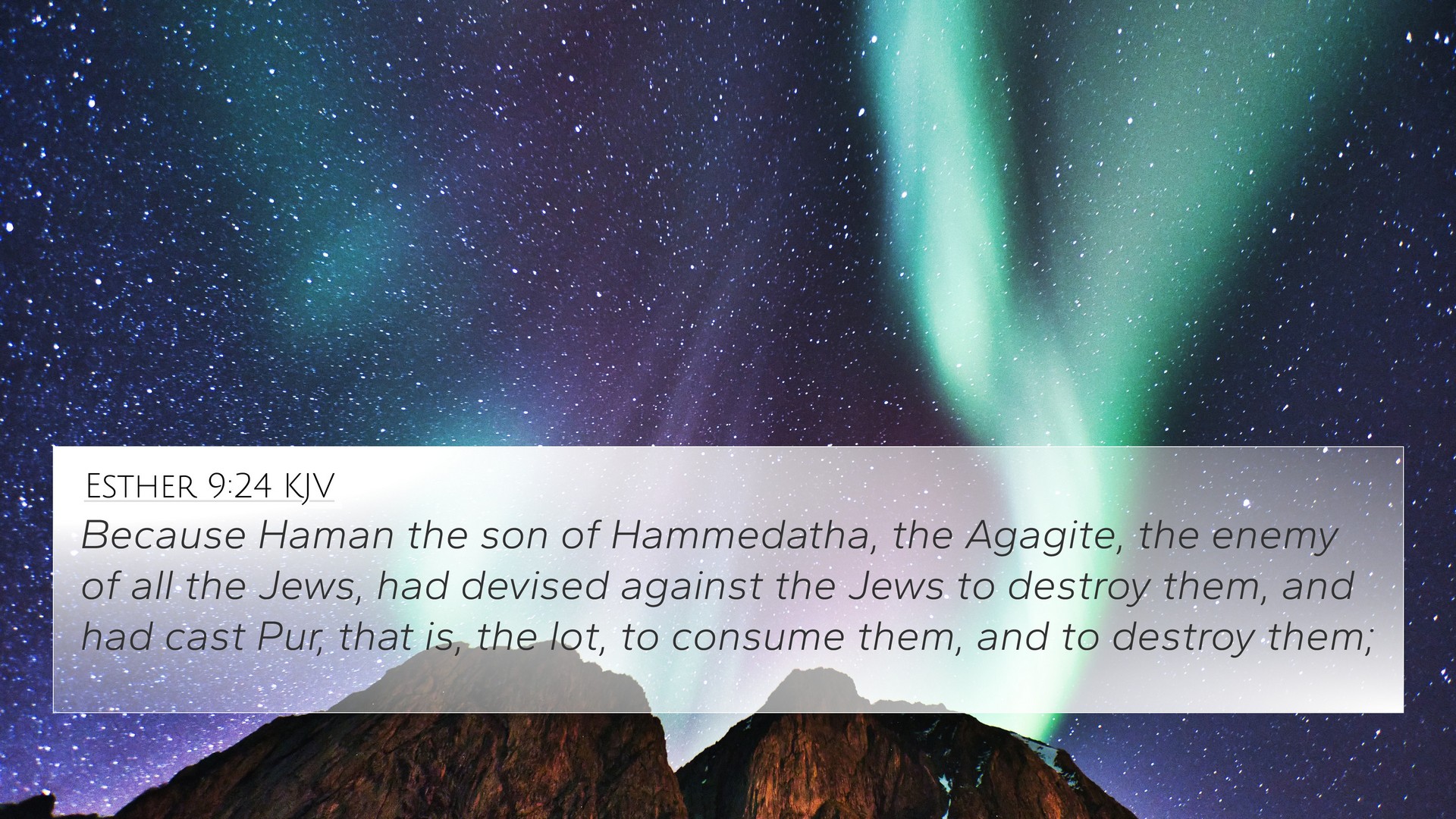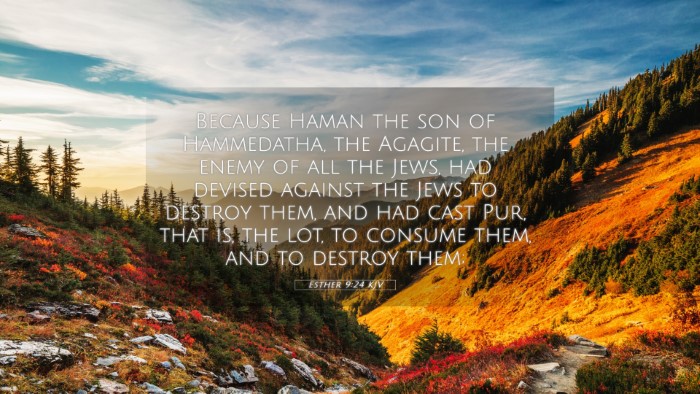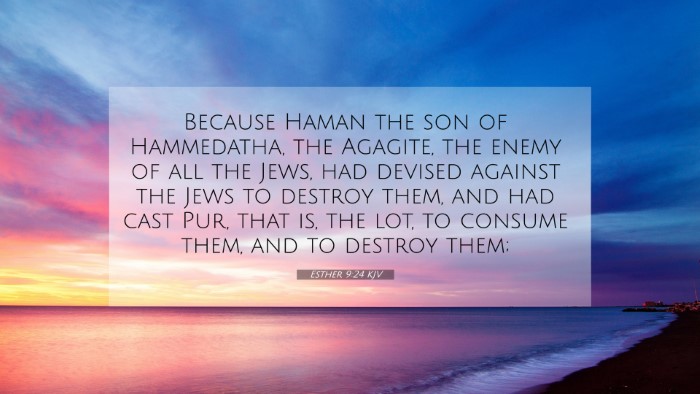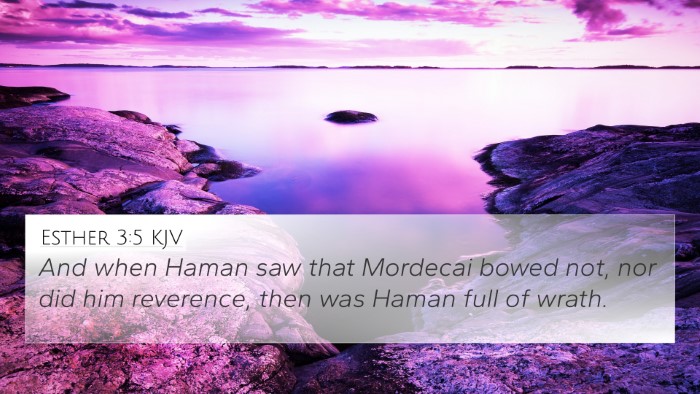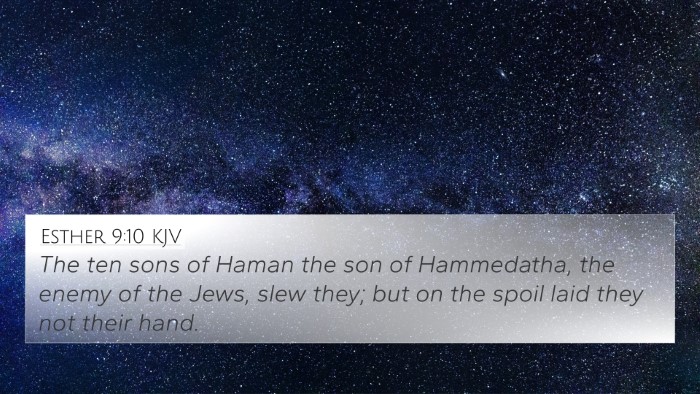Understanding Esther 9:24
Esther 9:24 presents a pivotal moment in the narrative of the Jewish people, encapsulating the themes of deliverance and the establishment of a lasting commemoration of their salvation. The verse explicitly identifies Haman's plot against the Jews, thereby laying a foundation for the Feast of Purim, which celebrates their triumph over oppression.
Commentary Insights
This verse states: "Because Haman, the son of Hammedatha the Agagite, the enemy of all the Jews, had plotted against the Jews to destroy them, and had cast the Pur, that is, the lot, to consume them, and to destroy them." The commentaries by prominent Biblical scholars provide profound insights into the meaning of this verse:
- Matthew Henry: Henry emphasizes the significance of divine providence in the deliverance of the Jews. He notes that despite Haman's wicked intentions, God intervened to protect His chosen people. This highlights the overarching theme of God's sovereignty and mercy throughout Scripture.
- Albert Barnes: Barnes elaborates on the term Pur, explaining its roots in ancient practices where lots were cast to determine fate. This illustrates the seriousness of Haman's malice and God's ultimate authority over fate. Barnes notes that the Jewish festival of Purim serves as a reminder of their deliverance from such plots.
- Adam Clarke: Clarke delves into the characteristics of Haman, the Agagite, drawing connections between his lineage and ancient enmity toward the Jews. He underscores the importance of remembering these events as a way of honoring those who suffered and recognizing the danger of hatred, which resonates throughout history.
Key Themes in Esther 9:24
This verse encapsulates several critical themes:
- Oppression and Deliverance: Haman represents oppression, while the victory of the Jews symbolizes divine deliverance.
- Memorialization: The institution of Purim highlights the importance of remembering and celebrating God's deliverance.
- Divine Justice: The plot to destroy the Jews ultimately leads to Haman's downfall, illustrating the theme of divine justice.
Bible Verse Cross References
Esther 9:24 finds connections to various other scripture passages which enhance the understanding of its themes:
- Exodus 17:14: "Then the LORD said to Moses, 'Write this on a scroll as something to be remembered and make sure that Joshua hears it...'" - This emphasizes the idea of remembering significant events of divine intervention.
- Psalm 30:5: "For his anger lasts only a moment, but his favor lasts a lifetime; weeping may stay for the night, but rejoicing comes in the morning." - A reflection of the transition from sorrow to joy that the Jews experienced.
- Psalm 22:27-28: "All the ends of the earth will remember and turn to the Lord..." - This illustrates how deliverance leads to a broader recognition of God's power and mercy.
- Isaiah 54:17: "No weapon forged against you will prevail..." - A reminder of God's protection over His people against their enemies.
- Jeremiah 29:11: "For I know the plans I have for you..." - Reinforces the sovereignty of God in safeguarding His people.
- Matthew 5:10: "Blessed are those who are persecuted because of righteousness..." - This connects the suffering of the Jews to New Testament beatitudes, maintaining the theme of deliverance through trial.
- Romans 8:31: "What, then, shall we say in response to these things? If God is for us, who can be against us?" - A powerful declaration of faith in divine protection reminiscent of the events in Esther.
Thematic Bible Verse Connections
Esther 9:24 and its related verses paint a broader picture of God’s unwavering support for His people amidst trials:
- God’s Sovereignty: Throughout the Bible, there are consistent reminders of God's control over situations (Proverbs 21:1).
- The Importance of Remembrance: This highlights the value of traditions and festivals in the Jewish faith (Deuteronomy 16:3).
Conclusion
Esther 9:24 encapsulates a profound moment of triumph for the Jewish people, rooted in the narrative of divine providence against adversity. Understanding this verse through the lens of scholarly commentary and cross-references allows readers to appreciate the depth of its message. The incorporation of accompanying verses enhances the thematic analysis of deliverance, justice, and remembrance in the broader tapestry of the Biblical narrative.
